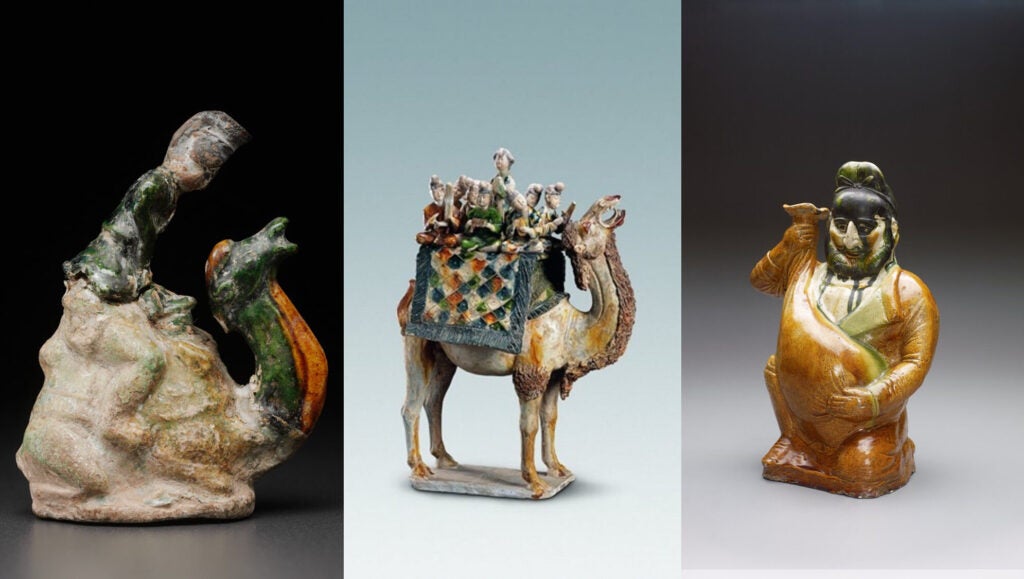Analyzing Ceramics Sheds Light on Xenophobia, 1300 Years Too Late
Original Georgetown University College of Arts & Sciences News post, from June 7th 2022: Analyzing Ceramics Sheds Light on Xenophobia, 1300 Years Too Late.

Sancai ceramics that Zheng analyzed as part of his research.
How do you know what people in the 7th century thought about outsiders? According to Xin Zheng (C’23), you should examine their pottery.
This spring, Zheng, a double major in art history and history, presented his paper on the depiction of ethnic minorities in Tang Dynasty (618-907) pottery at the SUNY New Paltz Undergraduate Art History Symposium. Zheng began his research in a course on Chinese art taught by Michelle Wang, a professor in the Department of Art & Art History.
“Chinese pottery has always captivated both foreign and domestic audiences,” Zheng says. “With the inclusion of foreign dancers, musicians, and animals in the design of sancai wares, one is left with the impression that foreigners were quite welcomed during the Tang dynasty.”
During the 6th and 7th centuries, foreigners were an established part of Chinese life – with some living and working in cities like Chang’an and Luoyang. Foreign goods were sold in marketplaces and foreign fashion was worn. While their presence could be understood as acceptance, Zheng argues that their depiction in sancai was anything but a celebration.
“We know that a lot of foreigners went to China as doctors, military advisors, lawyers and scholars,” Zheng says. “But they were not included in sancai. Instead, the depictions of outsiders emphasize their inferiority. You see foreign figures that are bare-chested, drunk or dancing. You don’t see any officials or military personnel included in the ceramic design”

Xin Zheng (C’23)
From Classroom to Colloquium
Zheng analyzed the artwork adorning tri-color glazed pottery, or sancai, to understand cultural attitudes around those depicted in the ceramics.
“Chinese pottery has always captivated both foreign and domestic audiences,” Zheng says. “With the inclusion of foreign dancers, musicians, and animals in the design of sancai wares, one is left with the impression that foreigners were quite welcomed during the Tang dynasty.”
During the 6th and 7th centuries, foreigners were an established part of Chinese life – with some living and working in cities like Chang’an and Luoyang. Foreign goods were sold in marketplaces and foreign fashion was worn. While their presence could be understood as acceptance, Zheng argues that their depiction in sancai was anything but a celebration.
“We know that a lot of foreigners went to China as doctors, military advisors, lawyers and scholars,” Zheng says. “But they were not included in sancai. Instead, the depictions of outsiders emphasize their inferiority. You see foreign figures that are bare-chested, drunk or dancing. You don’t see any officials or military personnel included in the ceramic design”
Art as an Educator
The sancai adorning tombs are more than a treasure trove of objects, the breadth of samples that have survived offer a fantastic lens through which to view Tang China. These wares don’t just represent first-hand accounts for an art historian, they are a phenomenal entrypoint for a fledgling researcher.
“Works of art and architectural sites both shape, and are shaped by, the historical moment in which they were created,” Wang says. “Like historians, art historians too are interested in questions of chronological succession and historical periodization. What sets art history apart is that art historians treat works of art and architectural sites as primary sources in their own right.”
For Wang, empowering undergraduates to engage in independent research is crucial to building a lasting love of scholarship.
“I find that students really enjoy engaging in independent research because they appreciate having the freedom to follow their own interests and they gain confidence by mastering a certain topic,” Wang says. “I’ve helped students develop their research by emphasizing interdisciplinary research methods, encouraging the use of non-English language scholarly literature, introducing scaffolded paper assignments, unessays, peer review activities, and looking out for opportunities for students to present or publish their research.”
After graduating next year, Zheng plans to pursue a Ph.D. in Art History in either Chinese or European art.
–by Hayden Frye (‘17)
- Tagged
- Research
- UG Students